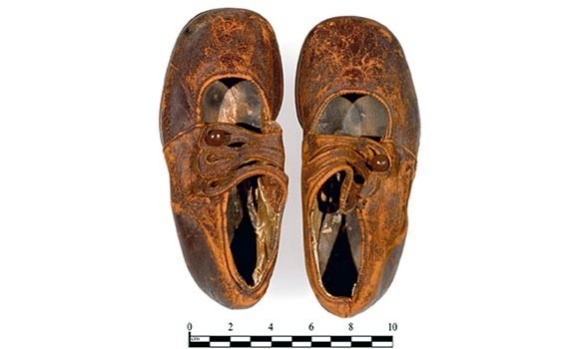Until now, he was known unofficially as the ‚Äúunknown child,‚Äù and officially as ‚Äúbody #4.‚Äù But almost 100 years after the sinking of RMS Titanic, the tiny lifeless boy pulled from the icy Atlantic has a name ‚Äî Sidney Leslie Goodwin ‚Äî thanks in part to the dogged research of –¬º”∆¬¡˘∫œ≤ ø™Ω±÷±≤• researcher Alan Ruffman.
The toddler’s body, dressed in a grey coat, brown serge frock, petticoat, pink wool singlet and brown leather shoes, was recovered with “no marks whatsoever,” according to notes taken of the victims by the crew of the recovery vessel, The Mackay-Bennett. It’s said the crew was so moved by the sight of the fair-haired boy that they took up a collection to pay for a tombstone, the one now dedicated to the “memory of the unknown child” in Halifax’s Fairview Lawn Cemetery.
≥“√∂≤ı≥Ÿ≤π?
–¬º”∆¬¡˘∫œ≤ ø™Ω±÷±≤• 10 years ago, anthropology professor Ryan Parr became intrigued about the century-old cold case after watching several videos about the famous shipwreck and its victims. Dr. Parr made a call to the Maritime Museum of the Atlantic offering the assistance of the Palaeo DNA lab at Lakehead University in Thunder Bay, Ont. to possibly identify some of the unidentified bodies laid to rest in three Halifax graveyards. He was referred to Mr. Ruffman, honorary research associate with –¬º”∆¬¡˘∫œ≤ ø™Ω±÷±≤•‚Äôs Department of Earth Sciences and a noted local expert on the wreck.
‚ÄúUp until then, my Titanic interest had been confined to scientific questions around the search for the wreck, the legal and national (Canadian) jurisdiction over the wreck in light of the 1982 Law of the Sea Treaty (UNCLOS) and matters concerning the pack ice, icebergs and the currents in the area on April 15, 1912,‚Äù explains Mr. Ruffman, who is also associated with –¬º”∆¬¡˘∫œ≤ ø™Ω±÷±≤•'s Marine and Environmental Law Institute at the Schulich School of Law.¬Ý


After a brief introduction, the two began exploring the task of getting the proper permissions, funding, as well as deciding which unidentified bodies would be suitable for DNA identification. They were led over the next year and a half to three unidentified bodies; body 240 (a 20-something male), body 281 (a middle-aged woman) and the unknown child No. 4 (a two-year-old boy).
They discovered there were only six male children that could possibly be the unknown child. The exhumations occurred on May 15 and 16, 2001.
At first, the unknown child was believed to be Gösta Leonard Pålsson, a two-year-old Swedish boy, after an eyewitness testified he saw him being swept off the deck of the ship. But there were five other boys that the body could have belonged to and Dr. Parr and Mr. Ruffman were determined to eliminate the doubt of his identity.
But like most research projects, there were obstacles.
Before family members could be contacted for permission to exhume the body, the team had to make sure their request was warranted.
“This was obviously a very controversial subject. We needed to make sure we had all our ducks in a row before approaching anyone about exhuming the body of the unknown child,” explains Mr. Ruffman.
With permission from the Pålsson family, the body of the unknown child was exhumed. All that remained in the coffin was a bone fragment and three teeth. The team of researchers used mitochondrial DNA (that’s passed from mother to child) to test against maternal relatives of the Pålsson family. When these results came back negative, Mr. Ruffman set out on another journey.
‚ÄúDr. Parr was at the Paleo-DNA lab doing the lab work. My side of the project was to locate the maternal descendants of the victims,‚Äù he says. ¬Ý
Through comparing the unknown child’s DNA with the other five boys maternal relatives, three of the children were immediately ruled out. After expert analysis on the teeth found in the coffin, the team concluded in 2004 that the unknown child was Eino Viljam Panula, a 13-month-old Finnish boy.
It wasn’t until a pair of small leather shoes surfaced in 2002 that caused Dr. Parr and Mr. Ruffman to question their conclusions.
A new discovery
Clarence Northover was a Halifax police sergeant in 1912 when the Titanic victims were brought in. He was responsible for guarding the bodies and possessions before being incinerated to prevent civilians from taking items as souvenirs. When it came time to burn the shoes, the sergeant couldn’t bring himself to get rid of them and so kept them in his desk. The shoes were then donated by Clarence’s grandson, Earle Northover, to the Maritime Museum of the Atlantic in Halifax.
The team concluded the shoes were too big for a boy of Panula’s age.
Footwear and clothing experts determined the shoes were of English origin and probably made between 1900 -1925. Dr. Parr and Mr. Ruffman, along with the U.S. Armed Forces DNA Identification Laboratory who helped identify victims of 911, re-opened the investigation and re-examined the DNA. Researchers now believe with 98 per cent certainty that the unknown child is Sidney Goodwin.
Sidney Goodwin was travelling from England to America. He was with his parents and five siblings whose remains have never been recovered.
A memorial service was held for relatives of the Goodwin family in August 2008. The family have decided to leave the headstone that reads, “Unknown Child” as it represents all the children that perished in the 1912 disaster.
Ten years after the journey began, the results of this study, will be published next month in the journal Forensic Science International.

